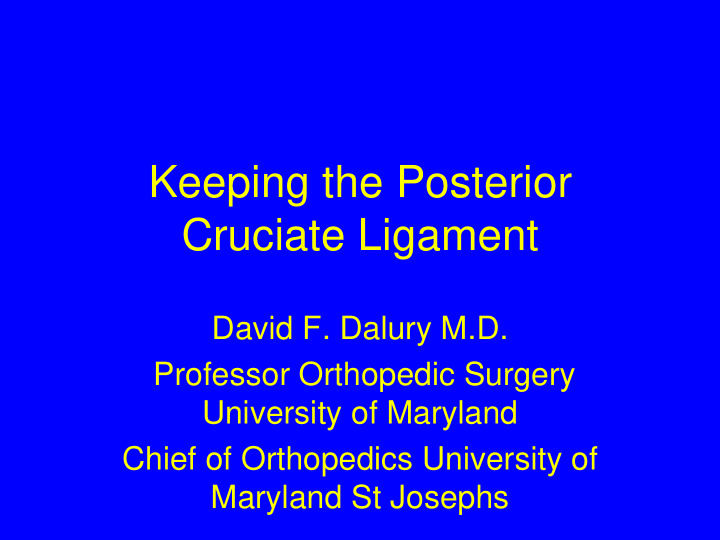



Keeping the Posterior Cruciate Ligament David F. Dalury M.D. Professor Orthopedic Surgery University of Maryland Chief of Orthopedics University of Maryland St Josephs
Disclosure • I receive royalties and consulting income from DepuySynthes
CR versus PS • More religion than science • Both work • I like CR because: – Knee feels more normal, less mechanical – Less bone removal – Almost no crepitus or clunk – Better long term results in most registries • I keep the CR 99% • I balance it 40%
PCL • If you retain it, you have to balance it
Cochrane Review 2013 • 17 RCT studies of 1810 patients and 2306 knees • NO DIFFERENCES BETWEEN CR AND PS – ROM (118 vs 116) – KSS pain score (both were 48.3) – KSS function score not statistically different – WOMAC (16.6 CR vs 15 PS) – Radiographic scores – Summary: no clinically significant differences
Australian orthopaedic association national joint replacement registry 2017 annual report Extracted from Table KT7 Cumulative Percent Revision of Primary Total Knee Replacement with Cemented Fixation Femoral Tibial N Revised N Total 1 Yr 3 Yrs 5 Yrs 10 Yrs 15 Yrs Component Component ATTUNE CR ATTUNE 49 5,691 0.6 (0.4, 0.9) 2.1 (1.4, 3.1) ATTUNE PS ATTUNE 18 2,693 0.4 (0.2, 0.8) 1.1 (0.6, 1.9) Genesis II CR Genesis II 466 13,669 0.9 (0.8, 1.1) 2.4 (2.1, 2.7) 3.1 (2.8, 3.4) 4.3 (3.9, 4.7) 5.6 (4.9, 6.5) Genesis II PS Genesis II 571 15816 1.2 (1.1, 1.4) 2.8 (2.6, 3.1) 3.7 (3.4, 4.0) 5.0 (4.5, 5.5) 6.2 (5.2, 7.3) NexGen CR Flex NexGen 315 19517 0.7 (0.6, 0.8) 1.5 (1.3, 1.7) 2.1 (1.8, 2.3) 2.8 (2.4, 3.2) NexGen LPS NexGen 956 29,701 0.9 (0.8, 1.0) 2.3 (2.1, 2.5) 3.1 (2.9, 3.4) 5.0 (4.7, 5.5) Flex Persona Persona 6 821 0.5 (0.2, 1.5) 1.5 (0.6, 3.5) PFC SIGMA CR PFC SIGMA 318 12,226 0.8 (0.7, 1.0) 2.0 (1.7, 2.2) 2.4 (2.1, 2.7) 3.4 (3.0, 3.9) 5.7 (4.6, 7.1) PFC SIGMA PS PFC SIGMA 274 7,600 1.2 (0.9, 1.4) 2.5 (2.2, 2.9) 3.2 (2.8, 3.6) 4.7 (4.1, 5.4) 7.2 (5.9, 8.8) Triathlon CR Triathlon 607 31,060 0.8 (0.7, 0.9) 2.0 (1.8, 2.2) 2.5 (2.3, 2.7) 3.9 (3.4, 4.5) Triathlon PS Triathlon 219 6,676 1.4 (1.2, 1.7) 3.1 (2.6, 3.6) 4.0 (3.4, 4.5) 5.1 (4.3, 6.0) Vanguard CR Maxim 178 7,915 0.6 (0.5, 0.8) 2.2 (1.9, 2.7) 2.9 (2.5, 3.4) 4.3 (3.5, 5.3) Vanguard PS Maxim 193 3,751 1.9 (1.5, 2.4) 4.5 (3.8, 5.3) 5.7 (4.9, 6.6) 7.5 (6.1, 9.3) Table KT22 Cemented Fixation 4,712 157,680 0.8 (0.8, 0.9) 2.2 (2.1, 2.3) 2.9 (2.9, 3.0) 5.1 (5.0, 5.3) 6.5 (6.2, 6.9) Australian Orthopaedic Association National Joint Replacement Registry Annual Report. (2017). Tables KT7, KT22, KT 23. Please note, the above table only includes selected Class data, Minimally stabilized TKR products based on the four largest device manufacturers by worldwide sales. Full summary of all data is available from: https://aoanjrr.sahmri.com/annual-reports-2017 Table KT23 Cemented Fixation 4,4774 124,375 1.1( 1/1, 1.2) 2.9 (2.8, 3.0) 3.9 (3.8, 4.1) 5.9 (5.8, 6.1) 7.8 (7/3, 8.2) Class data, Posterior stabilized
PCL Too Tight
PCL Now Balanced
Balancing the PCL
I use CR in 99% of knees, regardless of deformity Most common reason for PS is fixed valgus combined with flexion
CR Retention in > 15 Degree Deformity • AAHKS 2014 • 63 knees in 55 patients • 45 female; 10 male • 55 valgus; 8 varus • Minimum 10 year follow up • Knee Society Scores: 35-93 • 7 revisions: 3 infections; 3 polywear; 1 fx • Average time to revision for non PJI 9 yrs
Summary • Excellent long term data showing CR knees work • Balance of the PCL is critical to function and longevity of a CR knee • Understand how to balance the ligament and to assess intra-op balance • Surgery is an art…
Thank You
Recommend
More recommend